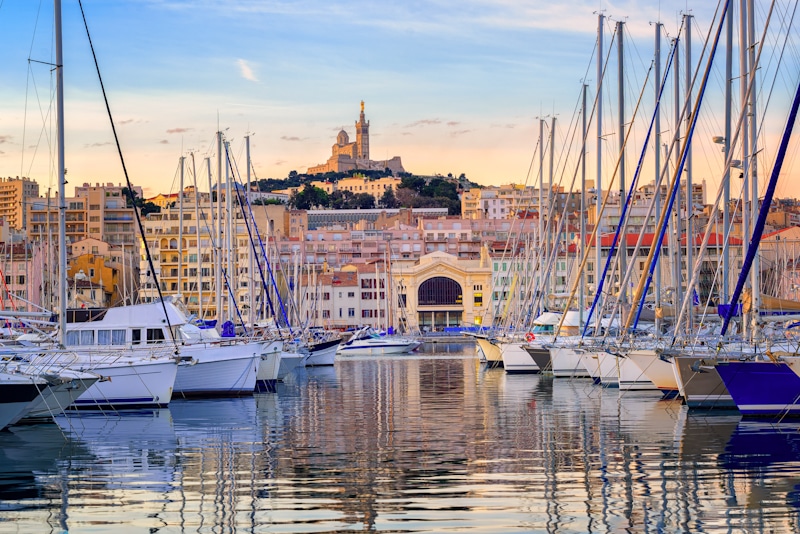We visit the historic quarter of France’s third-largest city and gateway to the vast, shimmering Mediterranean.
The Vieux-Port
The Vieux-Port de Marseille has provided an atmospheric setting for a long list of cinema classics. Some are edgy, like The French Connection. Others, including adaptations of Marcel Pagnol’s autobiographical novels, are altogether gentler. Sooner or later, you just have to go and discover the reality that inspired the conflicting imagery. When you do, you’ll soon discover a city so culturally diverse that whatever you’re expecting will actually be there somewhere.
The classic place to start exploring is on the Vieux-Port’s broad quaysides, which provided the setting for Pagnol’s celebrated trilogy: Marius, Fanny and César. Come here in the morning and you’ll find the day’s catches on sale in a celebrated daily fish market while the fishermen tend their nets nearby.
The port is actually much bigger than it’s usually portrayed on screen. Two very different passenger ferries provide a quick and enjoyable service between the southern Quai de Rive Neuve and its northern counterpart, the Quai du Port. ‘Le Ferry Boat’ is a modern, electrically powered catamaran bristling with solar panels. Its antique companion ‘César’ has been making the crossing since 1952 and offers a more nostalgic experience.
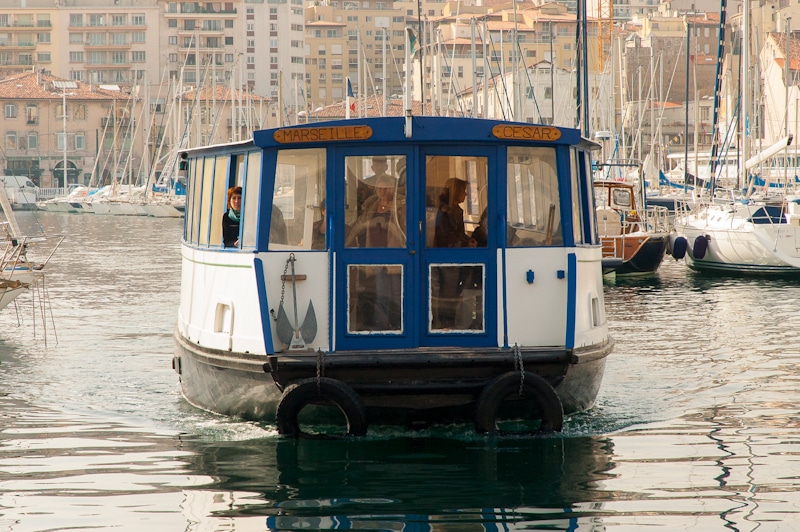
Further back in time, both foot passengers and car drivers were hauled across the harbour entrance on the deck of a huge skeletal pont-transbordeur, just like the example preserved at Rochefort. It was destroyed by German forces in 1944.
The site has been occupied for at least 26 centuries. It began welcoming strangers in 600BC when local Celto-Ligurian tribes were joined by Greek explorers from what is now Turkey. By the 4th century, vessels from the port of Massilia (as they had christened the settlement) were visiting the coasts of Africa, the British Isles and even the Arctic Circle to establish trading links. The arrival of the Romans in 49BC produced new overland routes, and Massilia became the most important centre of trade in the Mediterranean, with an additional military role that required the port’s existing defences to be strengthened against the threat of seaward attack.
Notre-Dame-la-Garde
Today road traffic crosses via a tunnel, unseen by the fishermen and leisure sailors whose movements unfold under the benevolent gaze of a huge gilded statue of the Virgin & Child. It crowns the bell tower of Notre-Dame-la-Garde, a neo-Byzantine basilica completed in 1864 on an elevated site that had been a place of pilgrimage since at least the early 13th century.
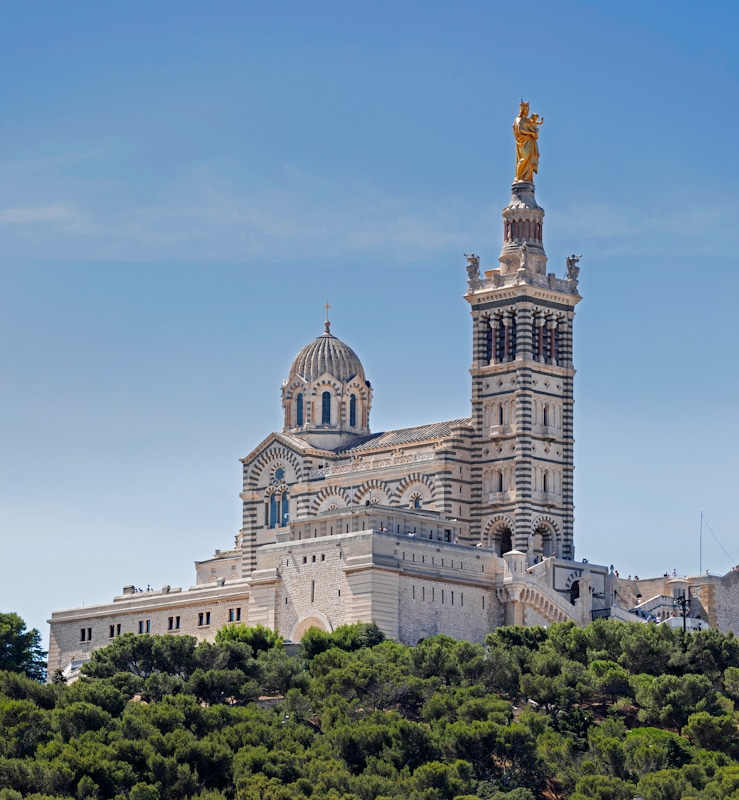
In order to survive the site’s exposed situation, the tough darker stone chosen for its striking polychrome effect was quarried near Florence. The basilica’s massive foundations are actually the ramparts of a fortress built to defend the town by order of François 1er in 1536. The site’s spectacular panoramic views take in the city, the Mediterranean coastline and various offshore islands. One of these islands is dominated by the Château d’If, another 16th century fortress and former prison described by Alexandre Dumas in The Count of Monte-Cristo.
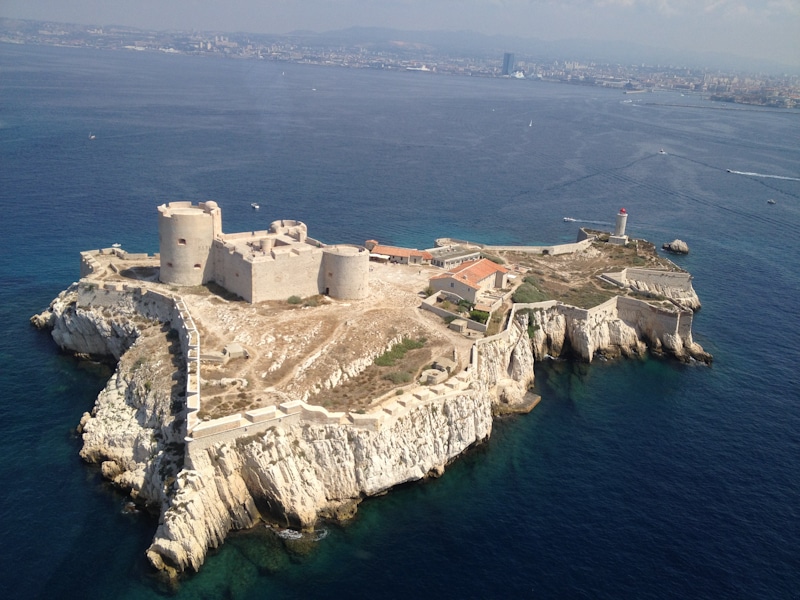
Fort Saint-Jean
Visible across the port on a site established by the Knights Hospitalier of Saint John of Jerusalem is the Fort Saint-Jean. Originally a point of departure during the Crusades, it was transformed into a military complex to strengthen the Vieux-Port’s defences and was completed in 1365. Additional construction works included the creation of the prominent Tour du Fanal, which served as a navigation aid for mariners.
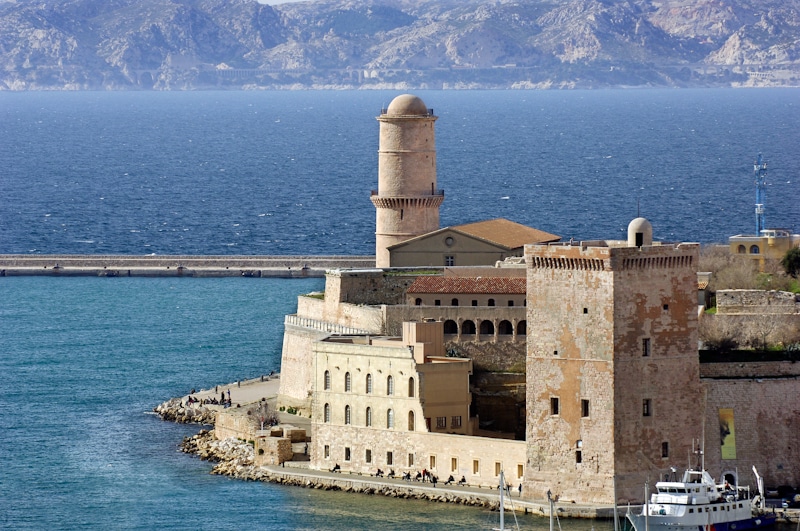
In 1666 Louis XIV ordered the construction of a new naval base, defended by two fortresses: the northern Fort Saint-Jean (incorporating a 12th century command post built by the Knights Templars) and the Fort Saint-Nicolas on the new southern development. After installing their seaward-facing artillery, the military engineers added an additional battery of cannons aimed in the opposite direction at the town, to dissuade the free-spirited Marseillais from questioning their loyalty to the monarchy.
Eventually the navy outgrew its facilities and transferred to nearby Toulon, where it remains. This left Marseille to develop its commercial activities. So successful was it that by the mid-19th century the volume of overseas trade forced a relocation of commercial maritime activity to the present purpose-built site at neighbouring La Jolitte, which possessed near-limitless expansion potential. With the pressure off, the vieux-port of Marseille once again assumed a new role, this time as the domain of local fishermen and leisure sailors.
Today the 30m high stone tower offers panoramic views of both old and new ports, the adjacent MuCEM (Museum of the Civilizations of Europe and the Mediterranean) and beyond it the 19th century Cathédrale Sainte-Marie-Majeure de Marseille. The cathedral shares Notre-Dame-la-Garde’s Byzantine/Roman Revival polychrome architectural style, but on a truly monumental scale.
Le Panier
Having got your bearings from the heights of the city’s most-visited seaward viewpoints, it’s time to take a deep breath and immerse yourself in ‘old Marseille’. You’ll find it tucked away just behind the Quai du Port in a maze of narrow streets and steep alleyways—a legacy of the ancient Phocean walled settlement founded right here on a cluster of hillocks.
Welcome to Le Panier, an area that polarises reactions like no other. Look beyond the graffiti tags and full-on wall art, and you’ll find places that have escaped defilement. These include peaceful, leafy squares whose elegant townhouses were once home to the Marseillaise bourgeoisie and have become highly desirable again, due in no small part to Le Panier having inspired France 3 TV’s hit series ‘Plus Belle la Vie’.
There are also boutiques, bars, bistros and restaurants whose vibrant painted shutters and ochre façades are more evocative of Naples, Corsica or the Maghreb. The different street levels are linked by rugged stone steps portrayed in The French Connection.
La Vieille Charité
Le Panier’s biggest surprise is a dazzling tour-de-force of neo-Classical architecture. ‘La Vieille Charité’ was constructed as a hospice and workhouse during the 17th century by order of Louis XIV to care for the area’s many sick and destitute. It was styled by Marseillais architect, sculptor and Baroque painter Pierre Puget, who provided statuary for the Château de Versailles.
Despite the Italianate elegance of its loggia-style arcades, rising through multiple storeys beneath a roof of Roman tiles, the complex had fallen into disrepair by the late 1940s and was scheduled for demolition. Its unlikely saviour was Swiss modernist architect Le Corbusier, who recognised its architectural importance and campaigned for it to be listed as an historic monument. Its subsequent epic restoration campaign lasted 25 years. Today the site houses two museums, several research institutions and a centre for contemporary poetry.
La Canebière
The city’s 16th and 17th century expansion behind the Vieux-Port produced an exodus of better-heeled families from Le Panier to altogether more desirable residential developments. At the heart of this area lies the broad, elegant boulevard of La Canebière. In time the process of urban gentrification spread to the Vieux-Port, which today has all the hallmarks of a flourishing Mediterranean tourist destination, including renowned restaurants and luxury hotels.
La Cité Radieuse de Marseille
The city itself is vast and takes time to really get to know, but for a glimpse of a very different aspect it’s well worth visiting one of its most startling architectural features. ‘La Cité Radieuse de Marseille’ (also known as ‘l’Unité d’Habitation’) was created by Le Corbusier to address an urgent need to replace in one structure much of the family housing lost during WWII.
The architect’s radical solution, inaugurated in 1952, is a symphony of prestressed concrete—a vertical village whose 337 duplex apartments, suiting everyone from singles to large families, would enjoy sensational views of either the surrounding parkland or across to the Mediterranean. He also provided a shopping centre, a laundry and cleaning service, a pharmacy, hairdressers, a library and a post office, not to mention a crèche, hotel accommodation (now L’Hôtel Le Corbusier) and a restaurant that originally provided delivery services to apartment residents.
Topping it all was a roof terrace with a solarium and children’s paddling pool (and since 2013 a contemporary arts centre). From the outset the pale grey of the exterior concrete was enlivened by vibrant colours, courtesy of English paint manufacturer Berger, applied to structural walls separating the individual balconies. Now the remarkable and much-loved structure is open to visitors, enjoys Monument Historique status and is listed by UNESCO as a World Heritage Site.
Parting thoughts? In many ways Europe’s largest commercial port is a world unto itself and defies you to remain indifferent. It’s Provence, but not as we know it.
